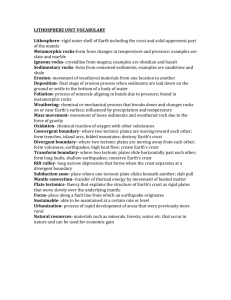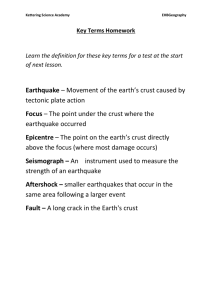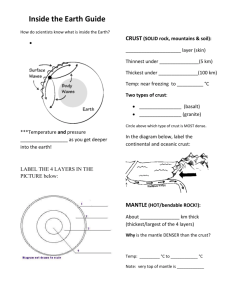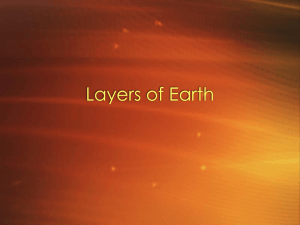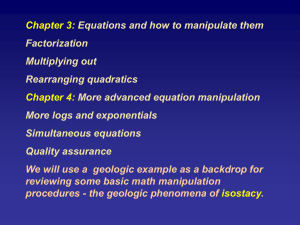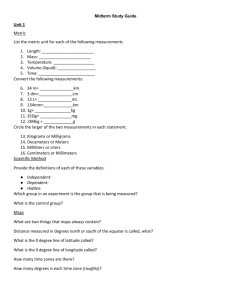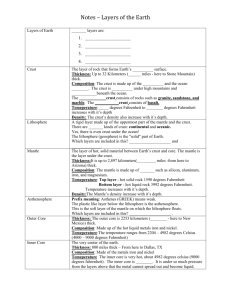The crust below the Indo-Myanmar Ranges of northeast India
advertisement
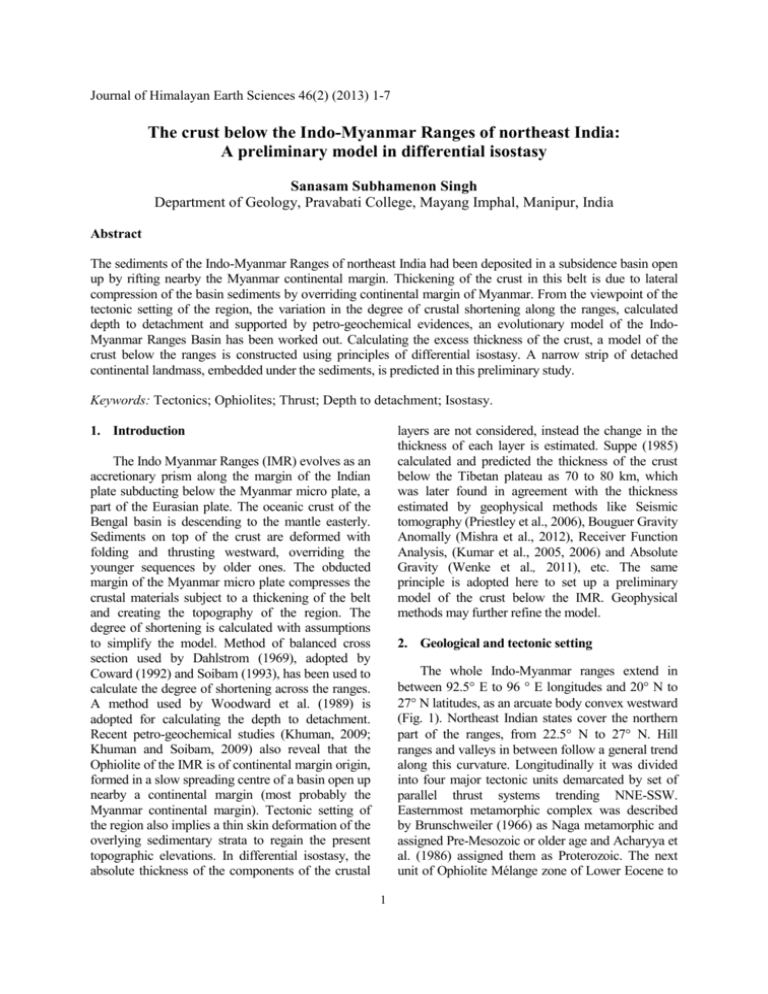
Journal of Himalayan Earth Sciences 46(2) (2013) 1-7 The crust below the Indo-Myanmar Ranges of northeast India: A preliminary model in differential isostasy Sanasam Subhamenon Singh Department of Geology, Pravabati College, Mayang Imphal, Manipur, India Abstract The sediments of the Indo-Myanmar Ranges of northeast India had been deposited in a subsidence basin open up by rifting nearby the Myanmar continental margin. Thickening of the crust in this belt is due to lateral compression of the basin sediments by overriding continental margin of Myanmar. From the viewpoint of the tectonic setting of the region, the variation in the degree of crustal shortening along the ranges, calculated depth to detachment and supported by petro-geochemical evidences, an evolutionary model of the IndoMyanmar Ranges Basin has been worked out. Calculating the excess thickness of the crust, a model of the crust below the ranges is constructed using principles of differential isostasy. A narrow strip of detached continental landmass, embedded under the sediments, is predicted in this preliminary study. Keywords: Tectonics; Ophiolites; Thrust; Depth to detachment; Isostasy. layers are not considered, instead the change in the thickness of each layer is estimated. Suppe (1985) calculated and predicted the thickness of the crust below the Tibetan plateau as 70 to 80 km, which was later found in agreement with the thickness estimated by geophysical methods like Seismic tomography (Priestley et al., 2006), Bouguer Gravity Anomally (Mishra et al., 2012), Receiver Function Analysis, (Kumar et al., 2005, 2006) and Absolute Gravity (Wenke et al., 2011), etc. The same principle is adopted here to set up a preliminary model of the crust below the IMR. Geophysical methods may further refine the model. 1. Introduction The Indo Myanmar Ranges (IMR) evolves as an accretionary prism along the margin of the Indian plate subducting below the Myanmar micro plate, a part of the Eurasian plate. The oceanic crust of the Bengal basin is descending to the mantle easterly. Sediments on top of the crust are deformed with folding and thrusting westward, overriding the younger sequences by older ones. The obducted margin of the Myanmar micro plate compresses the crustal materials subject to a thickening of the belt and creating the topography of the region. The degree of shortening is calculated with assumptions to simplify the model. Method of balanced cross section used by Dahlstrom (1969), adopted by Coward (1992) and Soibam (1993), has been used to calculate the degree of shortening across the ranges. A method used by Woodward et al. (1989) is adopted for calculating the depth to detachment. Recent petro-geochemical studies (Khuman, 2009; Khuman and Soibam, 2009) also reveal that the Ophiolite of the IMR is of continental margin origin, formed in a slow spreading centre of a basin open up nearby a continental margin (most probably the Myanmar continental margin). Tectonic setting of the region also implies a thin skin deformation of the overlying sedimentary strata to regain the present topographic elevations. In differential isostasy, the absolute thickness of the components of the crustal 2. Geological and tectonic setting The whole Indo-Myanmar ranges extend in between 92.5 E to 96 E longitudes and 20 N to 27 N latitudes, as an arcuate body convex westward (Fig. 1). Northeast Indian states cover the northern part of the ranges, from 22.5 N to 27 N. Hill ranges and valleys in between follow a general trend along this curvature. Longitudinally it was divided into four major tectonic units demarcated by set of parallel thrust systems trending NNE-SSW. Easternmost metamorphic complex was described by Brunschweiler (1966) as Naga metamorphic and assigned Pre-Mesozoic or older age and Acharyya et al. (1986) assigned them as Proterozoic. The next unit of Ophiolite Mélange zone of Lower Eocene to 1 Upper Cretaceous (Ghosh et al., 1980) is overlain by the older metamorphic. This ophiolite belt is thrusting westward over the Central Flysch Belt, composed of Disang sediments (Mallet, 1876) in the lower horizon and Barails (Evans, 1932) in the upper horizon. Older Disangs of Eocene to Upper Cretaceous thrusted over the younger Barails of Oligocene to Upper Eocene along the Churachandpur-Mao thrust zone, which is a prominent lineament on the western side of Imphal Valley in the Manipur Hills segment. The western most Molasses belt of Surma sediments of Miocene to upper Oligocene are in turn, overlain by Barails along the Barak-Makru Thrust lineament. Younger Tipam sediments of Miocene occupy the western part of the ranges in the part of the Northeast India. of the regional folds are also examined by using line balancing method and found that amount of shortening compensated by folding varies from north to south. In the southern part, regional shortening is almost compensated by folding but in the north only two-thirds of it, while the remaining is absorbed in thrust zones. Gravity anomaly data of the region (Rai et al., 1999) provides a crustal thickness of 53 Km average around the zone of maximum shortening of which the excess thickness of 33 Km is mainly contributed by the piled up strata of the Disangs, Barails and Surma sediments which occupies the central part of the range (20 Km is considered to be the thickness of the subducting oceanic crust). In the axial part of the line of maximum shortening, thickness of Disangs and Barails in the Naga Hills Flysch belt is 2 + 3 = 5 Km (Acharya, 1991). Thickness of Surma in this part is about 6 Km (Nandy, 1980). Assuming basement slice and Ophiolites contribute a thickness of 2 Km, the total original thickness of the compress strata will be approximately 13 Km. The present cross sectional extent of the compressed strata is about 80 Km. Degree of shortening calculated from these values is also approximately 60%, comparable with the regional shortening. So thickening of the crust in this region is mostly contributed by the deformation of the sedimentary layers. 3. Crustal shortening The degree of shortening across the Indo Myanmar Ranges (IMR) has been calculated along randomly chosen profile lines, and in between two major regional lineaments inferred (Table 1). The line of eastern foothills, also parallel with the course of Chindwin River has been taken pin line on the eastern side. Lineament of Naga thrust and BarakMakru thrust has been chosen the pin line on the western side. Area balancing techniques for calculation of shortening was used by Chamberlain (1910, 1919); Bucher (1933); Goguel (1962); Dahlstrom, (1969); Laubscher, (1976); Hossack, (1979); Coward, (1992) and Soibam, (1998). Method used by Coward (1992) subsequently adopted by Soibam (1998) has been applied to calculate the degree of shortening along the profile sections. It is assumed that lateral shortening is compensated by thickening only. Neglecting the factor of compaction gives the value of original width a little less, but the error may not be too much exaggerated for the preliminary study. The degree of shortening has a maximum value of approximately 60% around the Manipur Nagaland state boundary. Shortening is reduced northerly as well as southerly. There is some deviation of the curve around the middle part of the Manipur Hills segment where the degree of shortening reduces much. Soibam (2001) had explained this abnormality due to longitudinal extension of the part of the Manipur valley by shearing. The extension was compensated by subsidence of the topography and subsequently reducing the cross section area of the profile giving a reduced shortening value. The degree of shortening 4. Depth to detachment It is clear that the rate of shortening is not uniform even along a particular section also. The degree of shortening shared by the local folds as well as inferred fold bands in between major thrust planes are less than the degree of regional shortening along the profile section nearby it. Under the same plane strain condition (Woodward et al., 1989), if original width (Lo), final width (Lf) and area A is known then, the depth to detachment (d) is calculated by equation 1 as: d A Lo Lf ………………… (1) An attempt is made to calculate the value of ‘d’ in some selected sections and found that these folding horizons confine to a shallow depths, less than 5 Km, at the most 15 Km from the datum line chosen, that is the MSL. The calculated values are given in Table 2. 2 Table 1. Shortening along randomly selected profile lines across IMR. Profile No. 1 2 3 4 5 6 7 8 9 10 11 12 13 14 15 Final width(Lf) 147.95 147.80 147.50 124.85 124.76 124.60 123.13 121.13 127.07 125.90 125.63 82.62 111.44 115.95 121.69 Original width (Lo) 213.08 282.76 291.50 248.92 250.96 313.09 239.20 193.75 152.87 152.13 165.79 143.69 187.28 192.57 175.57 Fig. 1. Profile sections along which shortening is calculated. 3 e% 30.57 47.73 49.40 49.84 50.29 60.20 48.52 37.48 16.88 17.24 24.22 42.50 40.49 39.78 30.69 Table 2. Depth to detachment calculated from inferred folds and regional shortening. Sections Aizawl Gelmol Kamjong Chingai Jessami Lo (km) 34.5523 1.529 11.4 14.775 15.862 Lf (km) 30.0005 1.294 9.6 13.183 13.861 A (km2) 21.8485 1.214 20.0 18.719 28.59 Lo - Lf (km) 4.5518 0.295 1.8 1.592 2.001 It is found that the depth of detachment surface increase gradually from south to north up to the southern part of the Naga Hills segment. The values given may not be of high precision but it infers gradual deepening of the decollement surface as it approaches the zone of maximum shortening. d (km) 4.8 5.17 11.11 11.76 14.28 assumed that the subducting oceanic crust dipping to the mantle will not contribute to the thickening. Lateral compression is mostly confined to the sedimentary layers above the depth to detachment. These sedimentary layers above are responsible for the thickening of the crust. Piled up deformed sediments above the decollement depth contributes to this excess thickness Δhc. 5. The crust below Indo Myanmar ranges of northeast India 6. The Imr Basin The principle of differential isostasy (Suppe, 1985) is based on two relationships. First, the sum of the changes in masses of different sections in a column above any horizontal surface within the asthenosphere is zero. It means that there is no change in the total mass of a column above any datum in the asthenosphere. The relation is expressed as follows: Δ(ρwhw) + Δ(ρshs) + Δ(ρchc) + Δ(ρmhm) + Δ(ρaha) = 0 ………….(2) The IMR basin might have been evolved due to rifting and gradual subsidence along the continental margin of the Myanmar micro plate separating a narrow strip of the continent. A recent study on the ophiolites of Manipur Hills (Khuman, 2009) reveals that a slow spreading center might have been developed during the Cretaceous which had been closed soon due to the subduction of the Indian plate. Ophiolite of the IMR is likely to be the part of that newly formed oceanic crust emplaced during the tectonic process. The whole IMR is the uplifted and compressed strata on the western half of the basin pushed up by the obducted margin of the Myanmar plate. The contemporary sediments on the western half remains in the Chindwin basin, relatively undeformed. Stratigraphic sequences on these two halves are closely comparable upto Oligocene (Raju and Kapesa, 2010). Uplift of the basin begins during late Oligocene to Miocene. Where, suffixes a, w, s, c, and m indicates asthenosphere, water, sediments, crust, and mantle respectively, ‘ρ’ the density, and ‘h’ the thickness of the column. Secondly, the change in the elevation of the surface ΔE is equal to the sum of the changes in thickness. Mathematical expression is as follows: ΔE = Δhw + Δhs+ Δhc + Δhm + Δha ………………………. (3) For an approximate estimate of the thickness of the crust below IMR, following values are taken, The maximum width of the IMR basin has been deduced from the maximum value of original width in Table 1. The whole of the IMR basin would be double of the original width calculated and found to be approximately 600 km. Thickness of the sedimentary column has a direct relationship with the depth of the basin. The maximum thickness of sediment load accommodated by a fixed height of water column in a subsidence basin is given by the following relation: (𝜌 −𝜌 ) hs = 𝑤 𝑎 hw ....................... (6) ΔE = 2 km, average density of sediments and crust together, ρc = 2800 Kg/m3, average density of mantle and asthenosphere together, ρa = 3300 Kg/m3, (Suppe, 1985). Then, Δ (ρchc) + Δ (ρaha) = 0 ......... (4) And Δhc+ Δha = 2 ......... (5) Solving the equations 4 and 5, value of Δhc obtained is 13.2 Km. approximately. It may be (𝜌𝑠 −𝜌𝑎 ) 4 where, the suffixes w, a, s represent water, asthenosphere, and sediments respectively, h represents thickness and ρ the density. Assuming, the average thickness of the Disangs and Barails together is 10 Km (Muang, 1979), densities of water, asthenosphere, and sediments taken as 1000Kg/m3, 3300Kg/m3, and 2500Kg/m3 respectively, approximate estimation of the depth of water in the basin may be calculated as follows: overriding the crustal fragments while descending Indian plate slightly dragged down the basement layers below the present IMR. Horizontal compression is accommodated by thrust systems, following ramp-flat geometry model given by Twiss and Moores, (1992); Woodward et al., (1989); Suppe (1983); Boyer and Elliote (1982). Upper layers are folded with sharp anticlines along the thrust planes, which were prone to erosion and occupied by streams and major rivers. Thickness of the crust below the IMR calculated from gravity anomaly is averaged to 53Km. Decollement surface of the deformed layers is somewhere at a depth of 13 km. Hence crust below the IMR must contribute a thickness of about 40Km. If the subducting Bengal basin contributes 20 km, remaining thickness of 20Km may be the basement continental crust with undisturbed sediments underlying the deformed sedimentary layers. This lensoidal body might be overloaded by the sediments (Fig. 2). Presence of such a strip of crustal block can be investigated and confirm by geophysical methods like seismic tomography but in this preliminary study the facilities are not avail. The concept of the evolution of this basin in a slow spreading centre can be affirmed by such geophysical evidences. Following the uplift of the IMR, the basin transgressed towards south westerly where molasses sediments are deposited. Variation in the degree of shortening infers the zone of maximum compression, which corresponds to the middle part of the basin, widest and deepest. Ophiolites are also better exposed in this zone. Depth to detachment reduced towards south which may be due to decrease in the thickness of the sediments or decrease in the compression stress. 1000−3300 10 = 2500−3300hw or hw = 3.48 Km (approximately). However, this much depth of water would not be attained in the beginning as the subsidence was gradual and at the same time sedimentation was also gradual. Depth of the basin at the time of volcanism activity, referred from the vesicle sizes in the pillow lavas of Ukhrul is estimated around 2.5Km to3 Km (Khuman, 2009; Khuman and Soibam, 2009). 7. Discussion The basin might have been closed due to oblique subduction (Satyabala, 2003; Khan, 2005) of the Indian plate below Myanmar plate. Descending Indian plate could have exerted lateral pressure on the mantle lithosphere below the detached continental strip making it thickened. This thickening might have produced the buoyancy contrast (Yaoling et al., 2003) required for the Myanmar continental margin obducted over the western half of the IMR basin. Young oceanic crust in front of the Myanmar continent might have been broken down into imbricate slices and some fragments were emplaced pushing on top of the sediments. Myanmar continent advanced westerly, relatively to the Indian plate, Detached continental crust IMR Indian continental crust Lithosphere Myanmar continental crust Lithosphere Subducting Oceanic crust Mantle Fig. 2. Illustration of the proposed position of the detached continental crust below IMR. 5 Ghosh, S., Dutta, A., Chandrasekaran, V., 1980. Integrated Surveys in Ultramafic belt of Manipur. Geological Survey of India Miscellaneous Publications, 30 (4). Goguel, J., 1962. Tectonics. Freeman, San Francisco. Hossack, J.R., 1979. The use of balanced cross section in the calculation of orogenic contraction: a review. Journal of Geological Society of London, 136, 705-711. Ibotombi, S., 1993. Geology Structure and tectonics of Manipur, India, unpublished MS thesis, University of London, London. Ibotombi, S., 1998. Structural and tectonic analysis of Manipur with special reference to evolution of the Imphal Valley, unpublished thesis of Manipur University. Ibotombi, S., 2001. Imphal Valley A Transtensional Basin, DST, Project Completion report. Khan, P.K., 2005. Variation in dip angle of the Indian plate subducting beneath the Burma plate and its tectonic implications. Journal of Geoscience, 9 (3), 227-234. Khuman, M.C., 2009. Petrological and geochemical studies of ophiolite belt in parts of Chandel and Ukhrul districts, Manipur and their tectonic significance, Unpublished Ph.D. thesis of Manipur University, Imphal, India. Khuman, M.C., Ibotombi, S., 2010. Ophiolite of Manipur: its field settings and petrotectonic significance. In: Indo Myanmar ranges in the tectonic framework of the Himalaya and Southeast Asia, conference proceedings, Memoirs of Geological Society of India, 75, 255 -290. Kumar, P., Yuan, X., Kind, R., Kosarev, G., 2005. The lithosphere-asthenosphere boundary in the Tien Shan-Karakoram region from Sreceiver functions: evidence from continental subduction. Geophysical Research Letters 32, L07305. Kumar, P., Yuan, X., Kind, R., Ni, J., 2006. Imaging the colliding Indian and Asian lithospheric plates beneath Tibet. Journal of Geophysical Research 111, B06308. Laubscher, H.P., 1976. Fold development in Jura: Tectonophysics, 37, 337-362. Mallet, F.R., 1876. On the coal field of Naga hills, bordering the Sibsagar and Lakhimpur districts. Geological Survey of India Memoirs, 12 (2), 1-95. 8. Conclusions Crustal shortening and thickening in the part of Indo Myanmar Ranges is due to a thin skinned deformation. Excess thickness of the crust and elevation of the topography is contributed by the deformed sedimentary layers. The descending Indian oceanic crust does not contribute much to the thickening. To attain the total thickness given by gravity data, it is likely to present a strip of continental landmass embedded below the sedimentary layers. References Acharya, S.K., 1991. Late Mesozoic Early Tertiary basin evolution along the IndoBurmese range and Andaman island arc. In: Tandon, S.K., Pant, C.C., Casshyap, S.M. (Eds.), Sedimentary basins of India, Tectonic context. Gyanodaya Prakashan, Nainital, India, 104-130. Acharyya, S.K., Mitra, N.D., Nandy, D.R., 1986. Regional geology and tectonic setting of Northeast India and adjoining region. Geological Survey of India Memoirs, 119, 6-12. Boyer, S.E., Elliott, D., 1982. Thrust systems. Bulletin of the American Association of Petroleum Geologists, 66 (9), 1196-1230. Brunschweiler, R.O., 1966. On the geology of the Indo-Burman ranges (Arakan cost and Yoma, Chin Hills, Naga Hills). Journal of Geological Society of Australia, 13(1), 137-194. Bucher, W.H., 1933. The deformation of the Earth’s crust, Princeton. Chamberlain R.T., 1910.The Appalachian folds of the central Pennsylvania. Journal of Geology, 18, 228-251. Chamberlain, R.T., 1919. The building of Colorado Rockies. Journal of Geology, 27, 225-251. Coward, M.P., 1992. Lecture notes on course for M.Sc. Applied Structural Geology and rock mechanics (1992-93), Imperial College, University of London. Dahlstrom, C.D. A., 1969. Balanced cross section. Canadian Journal of Earth Sciences, 6, 743-757. Evans, P., 1932. Explanatory notes to accompany a table showing the tertiary succession in Assam. Transactions of Mining and Geology, Institute of India, 27, 155-260. 6 Mishra, D.C., Kumar, M.R., Arora, K., 2012. Long wavelength satellite gravity and geoid anomalies over Himalaya, and Tibet: Lithospheric structures and seismotectonics of deep focus earthquakes of Hindu Kush-Pamir and Burmese arc. Journal of Asian Earth Sciences, 48, 93-110. Nandy, D.R., 1980. Tectonic pattern in north eastern India. Indian Journal of Earth Sciences, 7, 103-107. Priestley, K., Debayle, E., Mckenzie, D., Pilidou, S., 2006. Upper mantle structure of eastern Asia from multimode surface wave form tomography. Journal of Geophysical Research, 3(B10304), 1-20. Qi Wang, W.S., Li, H., Wang, Y., Okubo, S., 2011. A Reinvestigation of Crustal Thickness in the Tibetan Plateau Using Absolute Gravity, GPS and GRACE Data. Terrestrial Atmospheric and Oceanic Science, 22(2), 109-119. Rai, S.S., Prakashan, K.S., Agrawal, N., 1999. Pn wave velocity and moho geometry in north eastern India. Proceedings of Indian Academy of Science (Earth Planet Science), 108 (4), 297-304. Raju, D.S.N., Kapesa, L., 2010. Status of Lithobio-chrono-sequence stratigraphic framework and depositional environments of Northeast India, Bangladesh and Myanmar - chart and explanatory notes. In: Indo Myanmar ranges in the tectonic framework of the Himalaya and Southeast Asia, conference proceedings, Memoirs of Geological Society of India, 75, 139-141. Satyabala, S.P., 2003. Oblique plate subduction in the Indo-Burma (Myanmar) subduction region. Pure and Applied Geophysics, 160, 1611-1650. Suppe, J. 1983.Geometry and Kinematics of faultbend folding. American Journal of Science, 283(7), 684-721. Suppe, J., 1985. Principles of Structural geology, Prentice Hall. Twiss, R.J., Moores, E.M., 1992. Structural geology. W. H. Freeman and Company, New York. Woodward, N.B., Boyer, S.E., Suppe J., 1989. Balanced geological cross-sections: an essential technique in geological research and exploration. American Geophysical Union, Washington, 132. Yaoling, N., O'hara, M.J., Pearce. J.A., 2003. Initiation of subduction zones as a consequence of lateral compositional buoyancy contrast within the lithosphere: a petrological perspective. Journal of Petrology, 44(5), 851-866. 7
